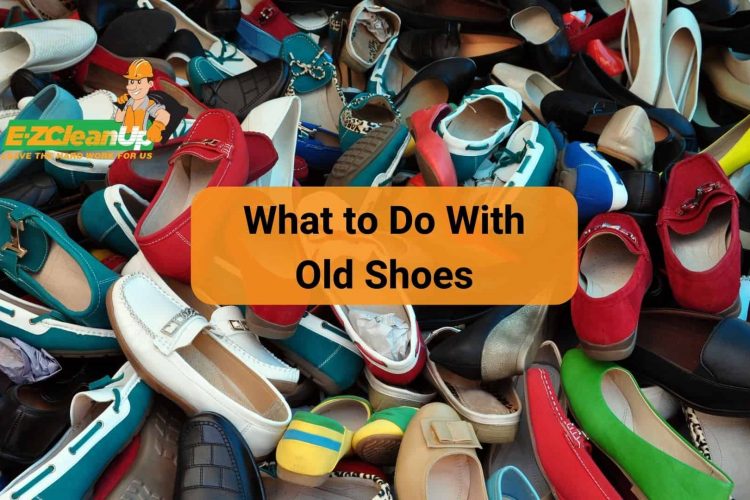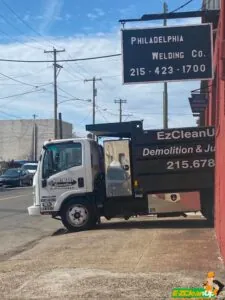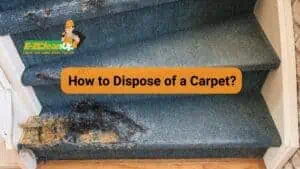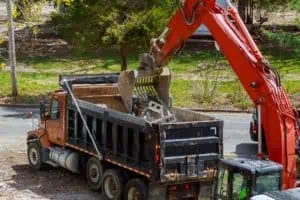Old shoes can be recycled, donated, upcycled, or sold online. Recycling options include local government efforts, while donation choices range from charities to international organizations. For a creative twist, transform them into planters, art, or functional household items.
Discover more innovative and sustainable ways on what to do with old shoes in our comprehensive guide.
Recycling Options for Old Shoes
When it comes to dealing with old shoes, there are several recycling and repurposing options available. You might not realize it, but your old footwear can still have plenty of life left in various forms.
Specialized Shoe Recycling Programs
There are several programs specifically designed for shoe recycling:
- The Salvation Army: It accepts gently worn shoes and ensures they continue to serve others.
- Soles4Souls: This is another notable program that has distributed millions of pairs of shoes worldwide. They accept all types of shoes as long as they are in new or gently used condition.
- Share Your Soles: Based in Chicago, it also collects new and gently used shoes for those in need.
Manufacturer-Specific Recycling Initiatives
Several manufacturers have their own recycling initiatives. Nike, for example, has the Nike Grind program, where old athletic sneakers are repurposed into materials for athletic fields, courts, and playgrounds.
Teva, in partnership with TerraCycle, also has a recycling program for sandals. These initiatives by manufacturers help recycle while promoting environmental sustainability.
Community and Local Government Recycling Efforts
Local communities and governments often have their own recycling programs. Some areas offer curbside recycling for shoes, where they are collected alongside other recyclables. It’s important to check with your local recycling company for specific details.
Moreover, community-driven initiatives often host collection drives or have drop-off points for shoe recycling.
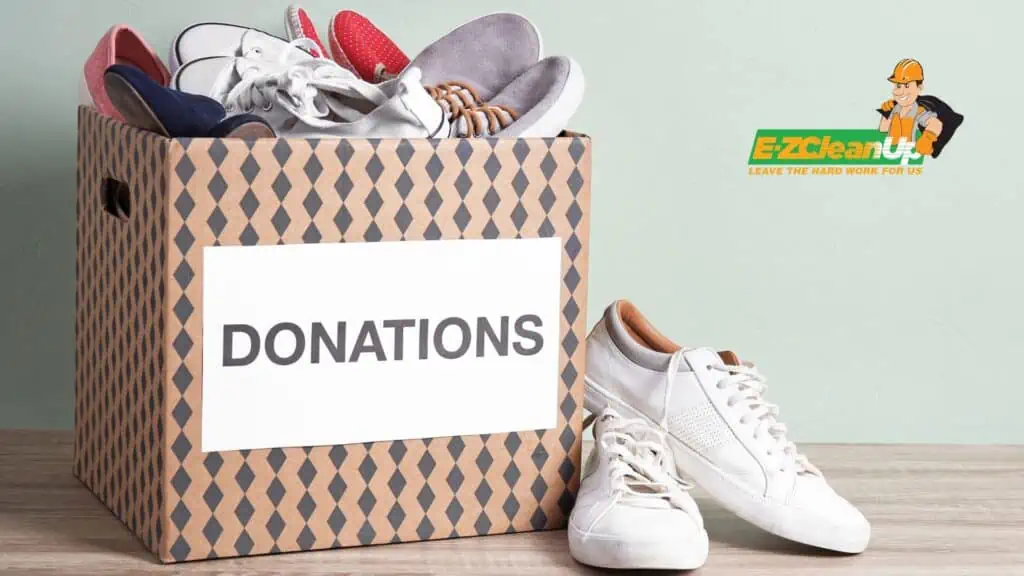
Donating Shoes: A Sustainable Choice
Donating old shoes can make a significant difference for both the environment and those in need.
Here’s a guide to help you understand the process and impact of shoe donations.
Criteria for Donatable Shoes
- Shoes in good condition: Many organizations, including Samaritan’s Feet, prefer gently used or new shoes for donation. Shoes should be clean and free from major damages like large holes or broken soles.
- Variety: Different types of shoes are acceptable, including athletic, running, dress shoes, sandals, and work boots. However, some organizations might have specific needs or restrictions.
Identifying Appropriate Charities and Organizations
- Local donation programs: Local organizations, churches, schools, and thrift stores often accept shoe donations. It’s a good idea to check with these entities in your community.
- National and international organizations: Larger organizations like Soles4Souls and Share Your Soles accept a broader range of shoes and have a wider reach.
Impact of Shoe Donations on Communities
Donating shoes provides essential footwear to people who might not be able to afford them otherwise. This can be crucial for protecting against foot diseases and injuries. It helps reduce waste in landfills and decreases the environmental impact of producing new footwear.
Some organizations sell donated shoes to fund their charitable activities, thereby creating a sustainable cycle of giving.
Upcycling and Creative Reuse of Old Shoes
Old shoes don’t have to end up in the trash. With a little creativity, they can be transformed into something new and useful.
Here are some ideas for upcycling and creatively reusing old shoes.
DIY Projects for Worn-Out Shoes
- Planters and Gardens: Convert high heels or running shoes into unique planters for succulents, cacti, or even a small herb garden. This idea recycles the shoes and adds a quirky touch to your garden or indoor spaces.
- Jewelry and Accessory Storage: Old shoes, especially high heels and flats, can be repurposed as jewelry racks for storing earrings, necklaces, and bracelets.
- Decorative Art: Transform your shoes into decorative pieces through techniques like decoupage or painting. This can turn a worn-out pair into a lovely display item for your home.
Using Shoes in Educational Settings
In educational settings, old shoes can serve as tools for artistic expression in art classes, where students can paint, decorate, or transform them into new objects. This approach is particularly effective in teaching concepts of recycling and sustainability.
Additionally, old shoes can be used in science projects to understand materials and design. They can offer practical insights into physics and engineering.
Community Art Installations with Old Shoes
Community art installations are a fantastic way to give old shoes a new lease of life. One notable example is the “Breath of the Spirit” installation by artist Chiharu Shiota, which involved tying red yarn to 600 pairs of worn-out shoes.
This installation not only recycled the shoes but also told the stories of the individuals who wore them. It created a deep connection between the viewers and the shoes.
Another example is the “Sole Expression: The Art of the Shoe” installation at Science Museum Oklahoma. This installation called for donated footwear of all kinds, accompanied by stories of their significance. The project aimed to showcase how shoes can evoke memories and express the journey of life.
Transforming Shoes into Functional Household Items
- Bookends and Storage: Repurpose high heels or boots into stylish bookends or use them as storage for small items around your house.
- Umbrella Holders and Organizers: Utilize tall boots, like rain boots or knee-high boots, as umbrella holders or for storing magazines, craft supplies, or gift wraps.
Community Workshops and Upcycling Events
Participating in community workshops or attending upcycling events can provide additional ideas and inspiration for repurposing old shoes. These events are great for learning new skills and connecting with others interested in sustainable living and DIY projects.
Selling Old Shoes Online
Selling your old shoes online is a great way to declutter and make some extra cash. The online marketplace offers various platforms where you can list and sell your gently used shoes.
Platforms for Selling Gently Used Shoes
- eBay: This platform is widely recognized for selling a variety of items, including shoes. eBay’s reach is global, giving you a higher chance of finding buyers. However, be aware of listing and selling fees, as well as shipping costs.
- Poshmark: This is popular for fashion items and accepts a range of shoe brands. The listing is free, but they charge a fee after the sale.
- Kixify: This is ideal for sneaker enthusiasts. Kixify specializes in sneakers and has no setup or listing fees, but it does take an 8% commission after a sale.
- GOAT: Best for selling rare or popular sneakers. They have a specific focus and a slightly complex fee structure, but it’s a great platform for sneaker sales.
Tips for Preparing Shoes for Sale
Keep the following in mind before posting your shoes and putting them up for sale:
- Clean and condition the shoes before photographing them.
- Take clear, well-lit photos from multiple angles to accurately represent the shoes.
- Be honest about the condition of the shoes in your description.
- Include brand, size, and any unique features in the listing to attract the right buyers.
- Research similar listings to gauge the market price.
- Consider the brand, condition, and rarity of the shoes when setting the price.
- Be open to negotiation, but set a realistic minimum price you are willing to accept.
- Factor in any platform fees and shipping costs when determining your selling price.
Understanding the Impact of Old Shoe Disposal
Disposing of old shoes might seem inconsequential, but it carries a significant environmental impact.
Environmental Consequences of Improper Shoe Disposal
Every year in the United States, over 300 million pairs of shoes are discarded, and a staggering 95% end up in landfills. Once there, shoes contribute to environmental contamination. They release chemicals into the soil and groundwater.
For instance, dyes from shoes can release heavy metals, while shoe soles made from materials like polyurethane decompose into harmful chemicals. Incineration of shoes is no better, as it adds toxic chemicals to the atmosphere. The process contributes to air pollution and poses health hazards, including increased cancer risks.
Carbon Footprint of Shoe Manufacturing and Disposal
The shoe manufacturing process is highly impactful in terms of carbon footprint. It’s estimated that shoe factories, required to meet the massive global demand for footwear, contribute 1.4% of global greenhouse emissions.
This significant environmental impact is due to the extensive use of fossil fuels in factories and the transportation of shoes worldwide, particularly from regions with cheap labor to global markets. The production of a single shoe results in the emission of about 30 pounds of carbon dioxide. Moreover, the use of non-renewable resources, such as coal, in shoe manufacturing worsens the problem.
The Scale of Shoe Waste Globally
Globally, the scale of shoe waste is enormous. Around 20 billion pairs of shoes are manufactured each year, and a significant portion ends up in landfills or is incinerated, contributing to environmental degradation. The issue extends beyond disposal, with the production stages of shoes significantly impacting the environment.
Only a small fraction of shoes are recycled, and due to the complexity of their materials, which often include a mix of plastics, metals, and adhesives, recycling shoes is challenging.
Responsible Disposal of Old Shoes
Getting rid of old shoes responsibly is important for both the environment and your personal space.
Evaluating Shoe Condition for Disposal
Before tossing out your shoes, it’s crucial to assess their condition. If they’re still wearable, it’s better to donate them to charity, a local thrift store, or even a shoe recycling program. However, if they’re beyond repair or worn out, recycling becomes a more suitable option.
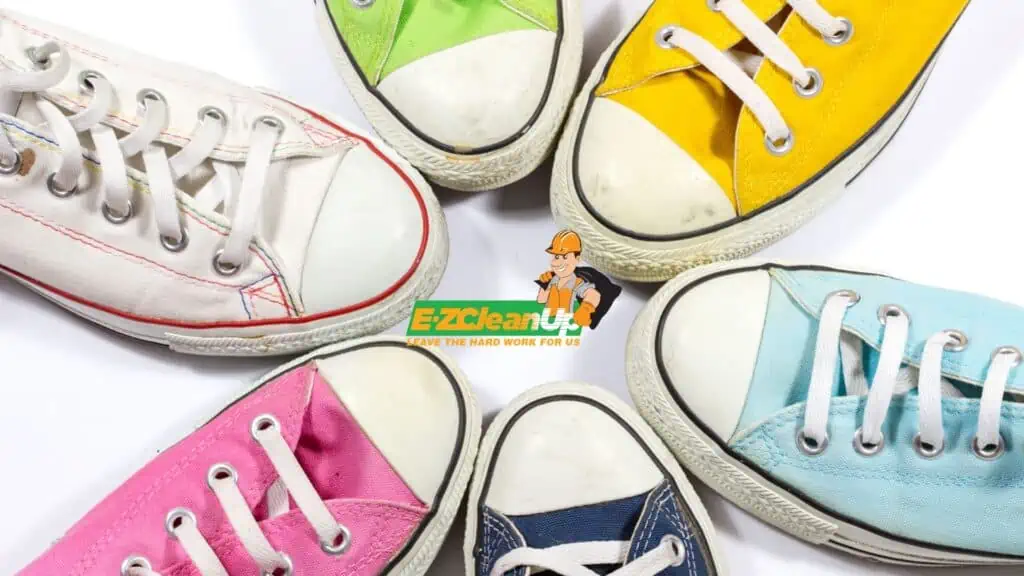
When to Consider Disposal: Signs of Irreparable Shoes
Recognizing when shoes are beyond saving is key. Look for signs, including the following;
- Severe wear on the toe box
- Significant wear on the midsole
- Noticeable wear on the outsole
- Visible heel drag
- Substantial wearing around the edges
- The insole showing significant wear, such as a faded symbol
When these indicators are present, it’s time to consider disposal or recycling options.
The Role of Shoe Material in Disposal Options
The material of your shoes plays a crucial role in determining the best disposal method. Shoes made from vinyl, leather, plastic, and other materials can take between 25 and 40 years to decompose in a landfill.
Given that an estimated 300 million pairs of shoes are discarded each year, it’s clear that landfills are overwhelmed with shoe waste.
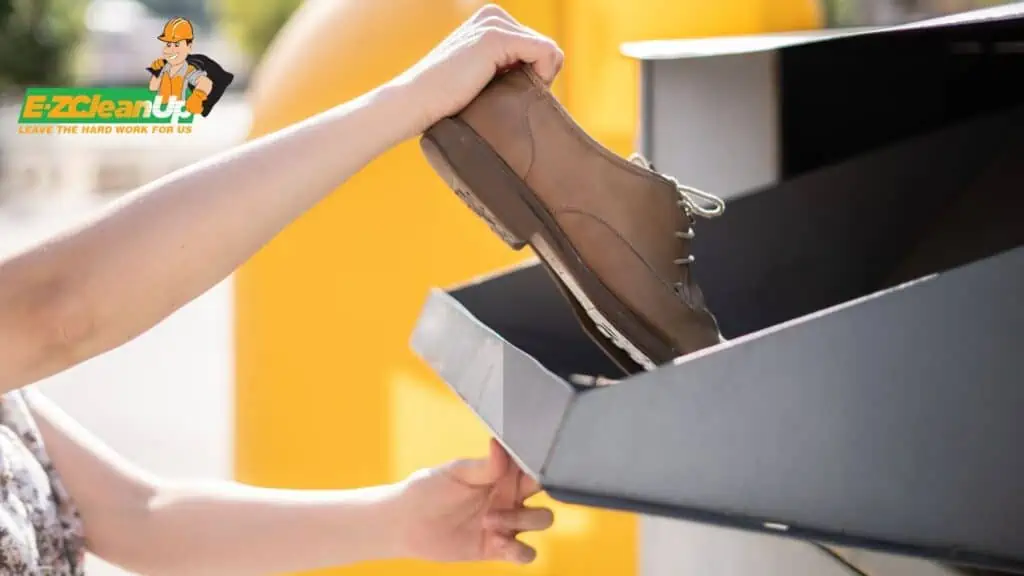
Stepping Up for the Environment
In a world where every step counts towards environmental sustainability, dealing with old shoes responsibly isn’t just a choice—it’s a necessity. By recycling, donating, or creatively repurposing old footwear, we’re not just clearing our closets; we’re contributing to a greener planet.
And if clearing your space of old shoes leads to a larger cleanup, don’t hesitate to reach out to us at EZ CleanUp. We’re here to help tidy up and haul away, making your environmentally conscious decisions easier and more efficient.

